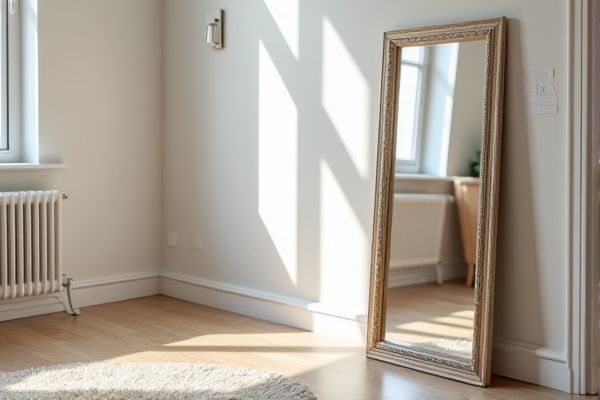
A standing mirror offers flexibility and convenience, allowing you to move and position it anywhere in your space, whereas a wall mirror saves floor space and adds a permanent decorative element to your room. Discover which mirror suits your style and space needs by reading the rest of the article.
Table of Comparison
| Feature | Standing Mirror | Wall Mirror |
|---|---|---|
| Installation | Free-standing, no installation needed | Requires mounting on the wall |
| Portability | Highly portable, easy to move | Fixed in one position |
| Size Options | Typically full-length, large sizes | Varies from small to large, customizable |
| Space Utilization | Uses floor space | Saves floor space, uses wall space |
| Style | Traditional, decorative frame options | Modern and minimalist designs available |
| Functionality | Ideal for full-body viewing | Good for accent or functional use (bathroom, hallway) |
| Durability | Stable but can be tipped over | Secure once installed properly |
| Price Range | Generally mid to high depending on frame | Varies widely; can be cost-effective |
Introduction to Standing Mirrors and Wall Mirrors
Standing mirrors offer full-length reflections with versatile placement options, ideal for bedrooms or dressing areas, while wall mirrors save space by mounting directly on walls, enhancing room aesthetics and light distribution. Your choice depends on available space and desired functionality, as standing mirrors provide mobility and ease of use, whereas wall mirrors contribute to room decor and can make smaller areas feel larger. Both mirror types serve distinct purposes in interior design, balancing practicality with style.
Key Differences Between Standing and Wall Mirrors
Standing mirrors offer portability and flexibility, allowing users to easily move and adjust the mirror's angle, making them ideal for dressing rooms or bedrooms. Wall mirrors save floor space and provide a more permanent, sleek solution that can enhance room decor and create the illusion of a larger space. While standing mirrors often feature a full-length design for outfit viewing, wall mirrors come in various shapes and sizes suited for both functional and decorative purposes.
Aesthetic Appeal: Décor Impact
Standing mirrors offer a bold, statement-making aesthetic that enhances room depth and reflects light, creating a dynamic decor impact. Wall mirrors provide a sleek, space-saving design that seamlessly integrates with your interior style, adding subtle elegance and visual balance. Choosing between the two depends on your spatial needs and the desired focal point in your decor.
Space and Placement Considerations
Standing mirrors offer flexible placement options and can easily be moved to different areas, making them ideal for larger spaces or rooms where wall installation isn't possible. Wall mirrors save floor space by being mounted directly on the wall, perfect for smaller rooms or areas with limited room for free-standing furniture. Your choice depends on the available space and whether you want a permanent fixture or a versatile mirror arrangement that can adapt to changing room layouts.
Installation and Mobility Comparison
Standing mirrors offer easy installation with no wall mounting required, allowing for effortless relocation and versatile placement in any room. Wall mirrors demand secure mounting hardware and professional installation to ensure stability, limiting mobility once positioned. The choice depends on whether a fixed, space-saving solution or a flexible, portable mirror is preferred.
Functional Versatility and Use Cases
Standing mirrors offer functional versatility through their portability and adjustable angles, making them ideal for bedrooms, dressing rooms, and retail fitting areas where flexibility is essential. Wall mirrors provide a fixed, space-saving solution for entryways, bathrooms, and living rooms, enhancing light reflection and creating the illusion of larger spaces. Both mirror types serve distinct use cases, with standing mirrors facilitating detailed outfit checks and wall mirrors optimizing spatial aesthetics and illumination.
Durability and Maintenance Factors
Standing mirrors often feature sturdy frames and stable bases, offering enhanced durability against daily wear and accidental bumps compared to wall mirrors. Wall mirrors require secure mounting hardware and regular checks to prevent loosening or damage, while standing mirrors provide greater flexibility and easier maintenance by simply repositioning or cleaning the frame and glass. Your choice should consider how much effort you're willing to invest in upkeep and whether you prefer a durable, mobile option or a fixed wall-mounted design.
Cost Analysis: Standing Mirror vs Wall Mirror
Standing mirrors typically cost between $50 and $300 depending on size, frame material, and design, offering portability and ease of placement without installation fees. Wall mirrors generally range from $40 to $250 but may incur additional costs for mounting hardware and professional installation, affecting overall expenditure. Choosing between the two depends on budget priorities, with standing mirrors providing flexible use and wall mirrors offering a more permanent decorative solution.
Safety and Stability Aspects
Standing mirrors offer enhanced stability due to their sturdy bases, reducing the risk of tipping over and causing accidents in your space. Wall mirrors, when properly installed with secure mounting hardware, provide safety by being fixed to the wall and out of reach from accidental bumps or falls. Assessing the structural integrity and installation methods ensures both mirror types contribute to a secure environment tailored to your needs.
Choosing the Right Mirror for Your Space
Standing mirrors offer versatile placement and full-body reflections, making them ideal for bedrooms and dressing areas where mobility and spaciousness are priorities. Wall mirrors save floor space and create the illusion of openness, perfect for smaller rooms or entryways needing a decorative yet functional element. Selecting between standing and wall mirrors depends on your room size, available wall space, and the desired aesthetic impact to enhance light and spatial perception effectively.
 homyna.com
homyna.com